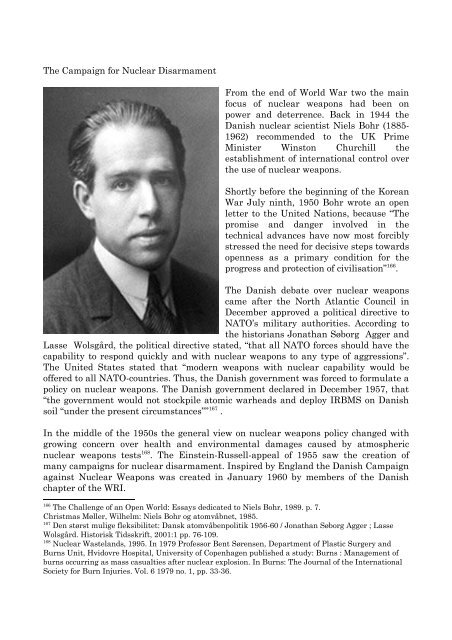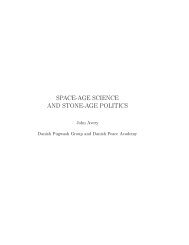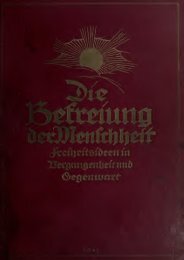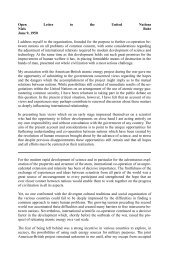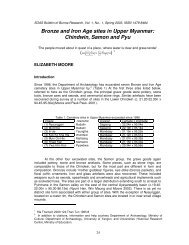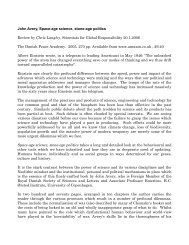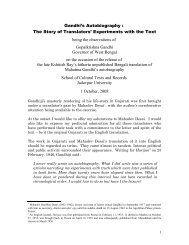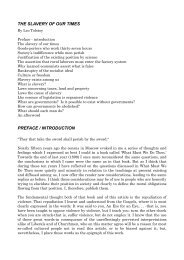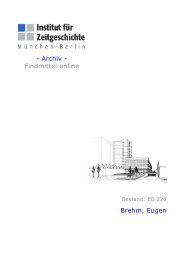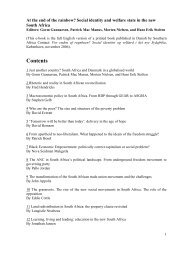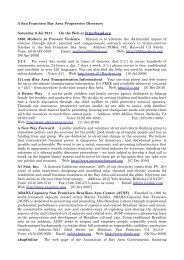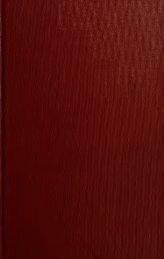Terp, Holger: Danish Peace History - Det danske Fredsakademi
Terp, Holger: Danish Peace History - Det danske Fredsakademi
Terp, Holger: Danish Peace History - Det danske Fredsakademi
You also want an ePaper? Increase the reach of your titles
YUMPU automatically turns print PDFs into web optimized ePapers that Google loves.
The Campaign for Nuclear Disarmament<br />
From the end of World War two the main<br />
focus of nuclear weapons had been on<br />
power and deterrence. Back in 1944 the<br />
<strong>Danish</strong> nuclear scientist Niels Bohr (1885-<br />
1962) recommended to the UK Prime<br />
Minister Winston Churchill the<br />
establishment of international control over<br />
the use of nuclear weapons.<br />
Shortly before the beginning of the Korean<br />
War July ninth, 1950 Bohr wrote an open<br />
letter to the United Nations, because “The<br />
promise and danger involved in the<br />
technical advances have now most forcibly<br />
stressed the need for decisive steps towards<br />
openness as a primary condition for the<br />
progress and protection of civilisation” 166 .<br />
The <strong>Danish</strong> debate over nuclear weapons<br />
came after the North Atlantic Council in<br />
December approved a political directive to<br />
NATO’s military authorities. According to<br />
the historians Jonathan Søborg Agger and<br />
Lasse Wolsgård, the political directive stated, “that all NATO forces should have the<br />
capability to respond quickly and with nuclear weapons to any type of aggressions”.<br />
The United States stated that “modern weapons with nuclear capability would be<br />
offered to all NATO-countries. Thus, the <strong>Danish</strong> government was forced to formulate a<br />
policy on nuclear weapons. The <strong>Danish</strong> government declared in December 1957, that<br />
“the government would not stockpile atomic warheads and deploy IRBMS on <strong>Danish</strong><br />
soil “under the present circumstances”” 167 .<br />
In the middle of the 1950s the general view on nuclear weapons policy changed with<br />
growing concern over health and environmental damages caused by atmospheric<br />
nuclear weapons tests 168 . The Einstein-Russell-appeal of 1955 saw the creation of<br />
many campaigns for nuclear disarmament. Inspired by England the <strong>Danish</strong> Campaign<br />
against Nuclear Weapons was created in January 1960 by members of the <strong>Danish</strong><br />
chapter of the WRI.<br />
166 The Challenge of an Open World: Essays dedicated to Niels Bohr, 1989. p. 7.<br />
Christmas Møller, Wilhelm: Niels Bohr og atomvåbnet, 1985.<br />
167 Den størst mulige fleksibilitet: Dansk atomvåbenpolitik 1956-60 / Jonathan Søborg Agger ; Lasse<br />
Wolsgård. Historisk Tidsskrift, 2001:1 pp. 76-109.<br />
168 Nuclear Wastelands, 1995. In 1979 Professor Bent Sørensen, Department of Plastic Surgery and<br />
Burns Unit, Hvidovre Hospital, University of Copenhagen published a study: Burns : Management of<br />
burns occurring as mass casualties after nuclear explosion. In Burns: The Journal of the International<br />
Society for Burn Injuries. Vol. 6 1979 no. 1, pp. 33-36.


